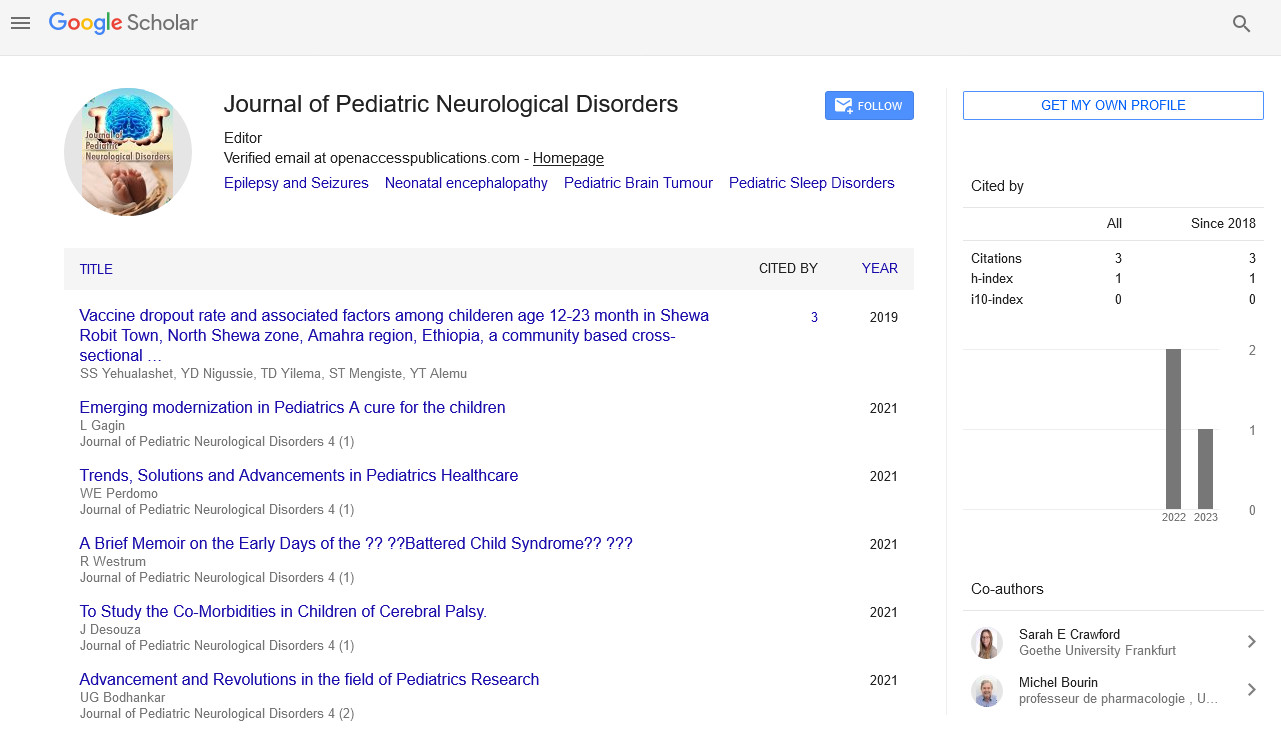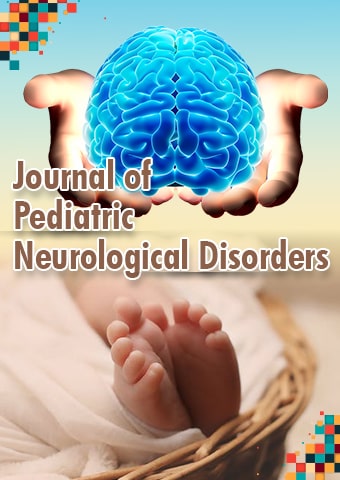Short Article - Journal of Pediatric Neurological Disorders (2019) Volume 2, Issue 1
Transcranial Magnetic Stimulation in Patients with Movement Disorders: A Review of Observational Study
Opeyemi Oluwasanmi Adeloye
Rosad Neurodegenerative Research Institute Jos, University of Medical Science Teaching Hospital, Ondo
Abstract
Transcranial magnetic stimulation is a painless non-invasive brain stimulation technique that used in cortical function in healthy individuals and inter alia, the pathophysiology of movement disorders. Many years, its use has evolved from primarily research purposes to treatment of a large variety of neurological and psychiatric diseases. In this article, we describe the theoretical background to TMS techniques and discuss the uses of TMS as a potential diagnostic tool in movement disorders. We also illustrate the basic principles on which the therapeutic use of transcranial magnetic stimulation is based and review the clinical trials that have been performed in patients with movement disorders.Introduction
Transcranial magnetic stimulation (TMS) is a painless non-invasive brain stimulation that affects the cerebral cortex but excluded deep structures. In patients with movement disorders the most common application of TMS has been to test the excitability of connections within and among motor areas of the cortex, which has provided useful information on pathophysiology; however, inter-individual variability in the responses has resulted in difficulties in translating this method into a clinically applicable diagnostic use. Cantello and colleagues reported that repeated stimulation (eg, 1 Hz for 20 min) can result in long-term plastic changes in the motor system, which has led to increased interest in possible therapeutic applications. Transcranial magnetic stimulation (TMS) uses magnetic field generator sends a current with peak amplitude of about 8000A, that lasts about 1ms, through an induction coil placed on the scalp. Experimental studies revealed that current creates a magnetic field that is perpendicular to the coil; this passes through the skull and induces an eddy current within the brain, parallel to the coil. If a sufficient intensity of stimulation is used, and the coil is held over the motor cortex, then descending volleys can be produced in the corticospinal pathway, and the resulting activation of muscles can be recorded by surface electromyography. Several studies also stated that TMS applications have been developed to investigate the physiology of the motor system from simple concepts that are used in clinical practice to complex sample. Complex applications have been used extensively to help understand the pathophysiology of movement disorders and tests of specific neural pathways. Studies revealed that TMS has been used to investigate mechanisms of synaptic plasticity in the cerebral cortex. Research from animals and in brain slices from animals to investigate the mechanisms of synaptic plasticity by different applications of electrical stimulation delivered through microelectrodes. These studies have identified two main types of post-synaptic, long-term plasticity: long-term potentiation (LTP) and long-term depression (LTD). The types of stimulation that most consistently produce LTP in animal studies are high frequency stimulation, which are typically given in an intermittent way (eg, 100 pulses at 100 Hz every 10 s for ten trials), whereas longer periods of lower frequency stimulation are applied to produce LTD (eg, 1–5 Hz ppulses given continuously for 20–30 min). Effective way of inducing LTP in animal studies, is by theta burst stimulation: a pattern of stimulation based on the firing arrangement that occurs in hippocampal neurons in rats, particularly when exploring novel environments. The basic pattern is high-frequency (50–100 Hz) bursts of 3–4 pulses repeated at about 4–7 Hz (the theta frequency in electro encephalogram terminology). Transcranial magnetic stimulators that can reproduce the stimulation patterns seen used in LTP and LDP studies in animals has opened the possibility of investigating the same mechanisms in the brains of conscious human beings.
Repetitive transcranial magnetic stimulation (rTMS)
This could be a therapeutic tool in the specialty of movement disorders by creating long-lasting changes in the excitability of synapses within the motor system to modulate symptoms. Many differences between the type of stimulation that is used in animal studies and rTMS given to human beings. First, the combination of high frequency and high-intensity stimulation that are used in animal studies can lead to seizures in human beings and, in view of this, internationally agreed safety guidelines set limits on the stimulation parameters used. In human beings, 5 Hz stimulation can induce an increase in cortical excitability that can outlast the stimulation by a few minutes; thus, frequencies greater than 1 Hz are traditionally thought to induce LTP-like effects in human beings.
High-frequency stimulation Impact
This is usually given intermittently (eg, 200 pulses, break for 1 min, a further 200 pulses, and so on, up to the maximum permitted limit); this pattern might be important with regard to the effects produced. A standard protocol to decrease cortical excitability uses 1 Hz stimulation, usually given in a continuous train of about 900–1800 pulses. An alternative use of rTMS has been developed that was modeled on theta burst stimulation in animals; the technique comprises short, repeating bursts of TMS pulse at 50 Hz. This seems to be a much quicker method to induce LTP-like or LTD-like changes, although has had limited use in therapeutic studies so far.
The effectiveness of rTMS
This also called LTP-like or LTD-like because it is not possible to record directly the effect of the stimulation at the level of the synapse in human beings; rather, the effect is inferred by changes in parameters such as the size of the motor evoked potential induced by a TMS shock of a particular intensity, or changes in functional imaging parameters. However, there are clear similarities between the effects of rTMS and LTP and rTMS and LTD that are induced in animal studies. For example, the effects of rTMS in humans beings can be modulated by NMDA antagonists, GABA antagonists, and electrical stimulation prior to rTMS in similar ways to LTP and LTD in animal studies. The effects of some forms of rTMS can be modulated by muscle contraction during and shortly after the stimulation. This event is important in the design of therapeutic studies (eg, asking the patient to move immediately after stimulation might abolish or change the effect of rTMS). To understand the design of therapeutic rTMS studies, a few technical points need to be highlighted. First, the intensity used to deliver rTMS is commonly related to the resting motor threshold (RMT) the minimum intensity of stimulation to the motor cortex that is needed to evoke a response in the target muscle. Therefore, in a typical study, investigators might describe their stimulation application as “20 min of 1 Hz of rTMS given at 90% RMT”. This means that TMS pulses were given continuously once per 20 min at an intensity of 90% of the RMT. With higher frequencies of stimulation, the total number of pulses is usually divided into trains, which are separated by intertrain intervals of various lengths. Secondly, therapeutic studies used repeated sessions of rTMS Studies in healthy individuals have shown that repeated sessions of rTMS (eg, daily sessions) can lead to a build-up of effects that might enhance any therapeutic benefits gained from a single application. Thirdly, participants with epilepsy or implantable electronic devices, such as pacemakers or deep brain stimulators are typically excluded from studies with rTMS. However, some investigators have, with appropriate safety measures used TMS in patients with deep brain stimulators. Lastly, a number of investigators have used some form of placebo stimulation in therapeutic studies. Two main methods are used: either a sham coil that looks similar and makes a sound that is similar to the discharge of a real TMS coil; or a real TMS coil that is held on the edge on the scalp (rather than fl at) and that does not discharge substantial amounts of magnetic energy into the brain. TMS given at high intensities (>90% RMT) induces a considerable sensation on the scalp, which is not replicated by current placebo coil methods, thus leading to a potential problem with unmasking of participants. A coil that incorporates an electrical stimulator that produces scalp sensation but does not stimulate the brain has been developed to improve the similarity between real and sham rTMS.

